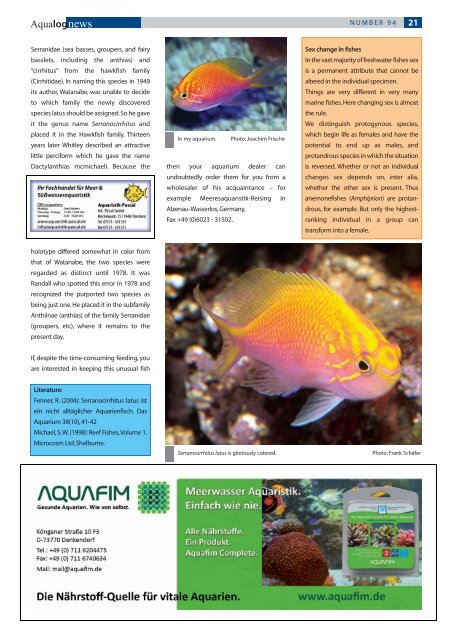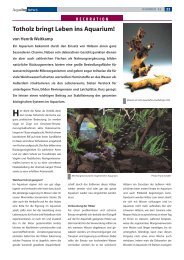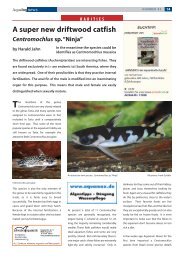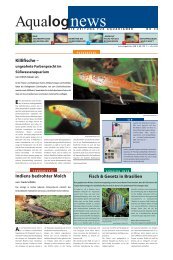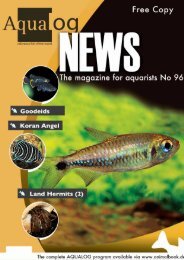LIVEBEARERS T Phallichthys tico - - a dainty new ... - Aqualog
LIVEBEARERS T Phallichthys tico - - a dainty new ... - Aqualog
LIVEBEARERS T Phallichthys tico - - a dainty new ... - Aqualog
Create successful ePaper yourself
Turn your PDF publications into a flip-book with our unique Google optimized e-Paper software.
<strong>Aqualog</strong><strong>new</strong>s NUMBER 94 21<br />
Serranidae (sea basses, groupers, and fairy<br />
basslets, including the anthias) and<br />
“cirrhitus” from the hawkfish family<br />
(Cirrhitidae). In naming this species in 1949<br />
its author, Watanabe, was unable to decide<br />
to which family the <strong>new</strong>ly discovered<br />
species latus should be assigned.So he gave<br />
it the genus name Serranocirrhitus and<br />
placed it in the Hawkfish family. Thirteen<br />
years later Whitley described an attractive<br />
little perciform which he gave the name<br />
Dactylanthias mcmichaeli. Because the<br />
holotype differed somewhat in color from<br />
that of Watanabe, the two species were<br />
regarded as distinct until 1978. It was<br />
Randall who spotted this error in 1978 and<br />
recognized the purported two species as<br />
being just one. He placed it in the subfamily<br />
Anthiinae (anthias) of the family Serranidae<br />
(groupers, etc), where it remains to the<br />
present day.<br />
If, despite the time-consuming feeding, you<br />
are interested in keeping this unusual fish<br />
Literature:<br />
Fenner, R. (2004): Serranocirrhitus latus ist<br />
ein nicht alltäglicher Aquarienfisch. Das<br />
Aquarium 38(10), 41-42<br />
Michael, S.W. (1998): Reef Fishes,Volume 1.<br />
Microcosm Ltd. Shelburne.<br />
In my aquarium. Photo: Joachim Frische<br />
then your aquarium dealer can<br />
undoubtedly order them for you from a<br />
wholesaler of his acquaintance – for<br />
example Meeresaquaristik-Reising in<br />
Alzenau-Wasserlos, Germany,<br />
Fax +49 (0)6023 - 31502.<br />
Sex change in fishes<br />
In the vast majority of freshwater fishes sex<br />
is a permanent attribute that cannot be<br />
altered in the individual specimen.<br />
Things are very different in very many<br />
marine fishes. Here changing sex is almost<br />
the rule.<br />
We distinguish protogynous species,<br />
which begin life as females and have the<br />
potential to end up as males, and<br />
protandrous species in which the situation<br />
is reversed. Whether or not an individual<br />
changes sex depends on, inter alia,<br />
whether the other sex is present. Thus<br />
anemonefishes (Amphiprion) are protandrous,<br />
for example. But only the highestranking<br />
individual in a group can<br />
transform into a female.<br />
Serranocirrhitus latus is gloriously colored. Photo: Frank Schäfer


